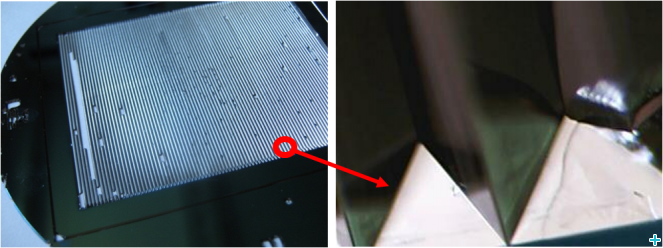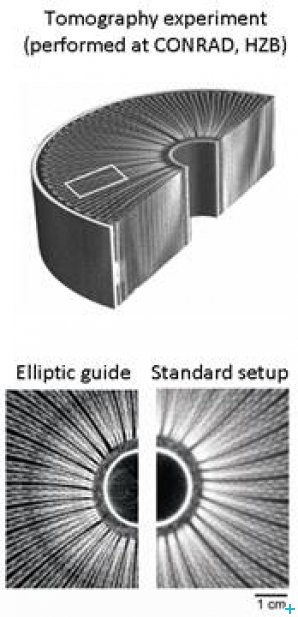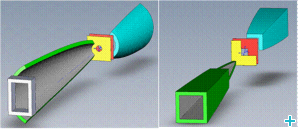The Neutron Optics JRA
The field of Neutron optics is revolutionising neutron scattering in the same way as the telescope empowered the astronomer's naked eye. Thanks to the technological advances made over the last decade, a number of optical concepts that were impossible to exploit until recently can now be applied to neutron optics. The aim of this JRA was to develop new optical components for neutron scattering spectrometers. Neutron scattering used to be the realm of large samples (1cm3). It is now possible to analyse sub-mm samples, and imaging at the µm scale will soon be within reach.
High flux reflectometry and energy analysis
One of the first tasks of this JRA was to investigate the possibility of increasing the efficiency of neutron reflectivity experiments. Several routes were proposed to enable the use of a very large part of the total flux available in the neutron guides.
The first route aimed at using reflective optics. The initial project was based on the REFOCUS concept, which has been upgraded. The new scheme named SELENE involves separating the monochromatisation and focussing functions, providing more flexibility to the design together with much easier implementation. A group of researchers at PSI has produced a prototype SELENE bench at half scale. The gains in flux obtained are of the order of 10 with respect to a conventional set-up.
In the second route, our JRA proposed that the energy analysis of a white neutron beam could be performed using the refraction in a prism. A large MgF2 crystal was bought by ILL in order to build an energy dispersive spectrometer. This provided data of a quality similar to time-of-flight data and can be easily implemented on any time-of-flight reflectometer. In high-resolution experiments it is possible to achieve gains in the range of 30-90. This can be useful for kinetic experiments or for measurements on small samples. To improve this set-up, HZB developed a technique for manufacturing arrays of silicon prisms using a chemical etching process. This allows perfectly aligned and smooth silicon prisms to be produced (fig 1). The use of several dozen prisms makes it possible to multiply the refraction effects by the number of prisms, thus proportionally increasing the deflection angles. A wafer of these prisms was stacked and characterised on the EROS reflectometer at LLB; it could be confirmed that they do behave as energy analysers.
Advanced focussing techniques
Phil Bentley has developed genetic algorithms for the optimisation of neutron optics. The use of genetic algorithms has shown that it would be possible improve the efficiency of focussing guides by 30%.
Some new McStas components were successfully used to model adaptive optics. A 1D parabolic focussing system has been extensively modelled using and a number of full-scale adjustable focussing devices were built and tested. The results agree with the numerical simulations. Two prototypes were built: one with an adjustable focal point and another with five motors to tune the mirror shape. Appropriate control software was written to be able to change the shape of the mirror without breaking it. A more advanced 2D focussing device was built for the instrument TOF-TOF at FRM II, enabling the curvature of the super-mirrors to be changed as a function of wavelength, in order to keep the focal point at the sample position. The team thus managed to double the flux at the sample position.
High resolution imaging using reflective optics
A group of scientists from this JRA has demonstrated using Monte-Carlo calculations that elliptic neutron guides lead only to minor distortions of the phase space and can therefore be used efficiently for neutron radiography and tomography. The group performed Monte-Carlo simulations for various imaging geometries using a straight guide, a convergent guide and an elliptic guide. It used a small section of an elliptic guide to demonstrate the principle of image magnification to achieve gains in spatial resolution. A significant improvement in image resolution was obtained, as shown in figure 2.
The neutron optics group at HZB led by Thomas Krist has designed and built a new type of high-resolution neutron-imaging detector. The small pixel size of the detector requires a high flux density for imaging experiments. The group has designed and optimised Kumakhov-type lenses for improved neutron beam focussing; these have provided a flux gain of 20x, allowing realistic exposure times of several minutes.
The new imaging facility CONRAD-2 was designed at HZB. This imaging facility using reflective optics provides a beam quality that can be used for imaging purposes. In future investigations the last guide section of the facility could be replaced by a focussing guide to re-assess the parameters of the facility.
Focussing SANS using reflective optics
The aim here was to design a focussing system on SANS spectrometers using an achromatic combination of curved supermirrors with no absorption (fig 3). SANS instruments could benefit from this technique in terms of flux at the sample. A test bench was produced at LLB and tested at PSI in September 2011 on the optical test beamline BOA.
The current device only provides improved performance in one direction. The overall set-up would perform better if focussing was possible in two directions, as shown in figure 4. This type of set-up is not technically feasible today. For this reason, a team of researchers tested the optical components of such a set-up on the optical beamline at BNC. Whilst the device provides roughly the expected performances, the optical imperfections observed are too large for SANS experiments. Thus for the new focussing SANS instrument at BNC, a Kirkpatrick -Baez arrangement combining two 1m-long elliptical mirrors will be used.
Modelling of interacting optical elements
There was a wish among users to avoid writing new components to describe new geometries / devices, given that there are already many useful components to build from. The problem is that McStas intrinsically uses a linear flow. Here we devised a solution to handle the assembly of basic optical elements to build a new McStas component. The technique was demonstrated on a “meta-component” including a guide with an embedded, wedged, polarising mirror system of the same type as the one at HZB.
Optical simulation workshops
Peter Willendrup, Linda Udby, Klaus Lieutenant, and Emmanuel Farhi organised a McStas/VITESS school in May 2010 on Ven in Sweden. Later in 2011, the group held another workshop on a more specialised use of McStas. The partners of the projects contributed several components to the McSTAS library.




